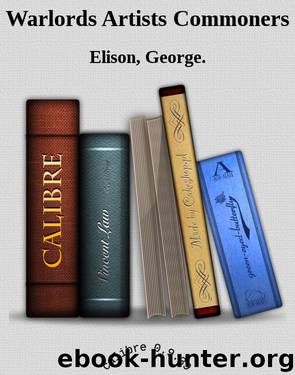Warlords Artists Commoners by Elison George

Author:Elison, George.
Language: eng
Format: epub
Published: 0101-01-01T00:00:00+00:00
Page 191
tionally been thought that this kind of ground brick tea was different from the supposedly more refined powdered tea ( matcha) that Eisai brought from China in the late twelfth century and that came to be used in the medieval Japanese tea ceremony. Professor Murai Yasuhiko, however, suggests from a careful reading of Ch'aching that the earlier "ground tea" and the later "powdered tea" may have been one and the same substance. 7 But as Murai is quick to point out, and as we shall see shortly, the question of whether or not dancha and matcha were the same was not as important in the evolution of the tea ceremony as the manner in which the tea was handled in the brewing process.
Lu Yü gained great fame as a tea master and was venerated in China not only as the founder of the Way of Tea but even as a god of the kitchen. Despite the eccentric and perhaps excessive personal behavior for which he is famous, Lu Yü regarded frugality and restraint as the essential qualities of the tea connoisseur's art. 8 He clearly believed that the use of tea should be governed by exacting rules of conduct and rigorous standards of good taste, and for these reasons he may rightly be regarded as the originator of the tea cult for both China and Japan.
From the life and writings of Lu Yü, we know how elegant and favored a pastime tea drinking had become in elite social circles in China by the late eighth century.
Considering the enthusiasm with which the courtier class of Nara Japan imitated the ways of China during that century, it is difficult to imagine that they did not become aware of the pleasures of tea or that they failed to pursue them. Yet the records are silent, and it is not until the early ninth century, after the move of the capital from Nara to Heian, that we find the first references to tea drinking in Japan. It is Saicho* (767–822), the patriarch of the Tendai sect of Buddhism in Japan, who is usually credited with introducing tea from the continent. He is said to have brought it back with him in 805, after a year's visit to China, and to have distributed it for cultivation to various places in the central provinces, including the Hie Shrine at the foot of Mount Hiei, where the headquarters of his sect were located. The source attributing the honor to Saicho is suspect, however, and we have no evidence from his own pen; rather, it was his rival and fellow visitor to China, Kukai* (774–835), the patriarch of the Shingon sect, who wrote of tea in his poetry and was the first Japanese author to use the characters subsequently read as chanoyu. 9
Whoever may properly claim the honor of its introduction, tea
Download
This site does not store any files on its server. We only index and link to content provided by other sites. Please contact the content providers to delete copyright contents if any and email us, we'll remove relevant links or contents immediately.
| Africa | Americas |
| Arctic & Antarctica | Asia |
| Australia & Oceania | Europe |
| Middle East | Russia |
| United States | World |
| Ancient Civilizations | Military |
| Historical Study & Educational Resources |
The Tale of Genji (unabridged) by Shikibu Murasaki(1011)
Japan by Edwin Reischauer(916)
The Complete Guide to Japanese Drinks by Stephen Lyman & Chris Bunting(893)
Shogun by James Clavell(842)
Native American in the Land of the Shogun: Ranald MacDonald and the Opening of Japan by Frederik L. Schodt(777)
The Pacific War by Robert O'Neill(771)
Japanese Notebooks by Igort(768)
Japanese Candlestick Charting by Steve Nison(724)
Shogun (The Asian Saga Chronology) by James Clavell(723)
Last Mission to Tokyo by Michel Paradis(717)
Bushido Explained by Alexander Bennett(696)
The Dutch Encounter with Tokugawa Japan by Adam Clulow(694)
The Pillow Book by Sei Shonagon(692)
The Great Road by Smedley Agnes;(683)
Ninja Fighting Techniques by Stephen K. Hayes(677)
Last Mission to Tokyo: The Extraordinary Story of the Doolittle Raiders and Their Final Fight for Justice by Michel Paradis(634)
Underground: The Tokyo Gas Attack and the Japanese Psyche by Haruki Murakami(628)
People Who Eat Darkness by Richard Lloyd Parry(618)
Comfort Woman by Maria Rosa Henson(615)
